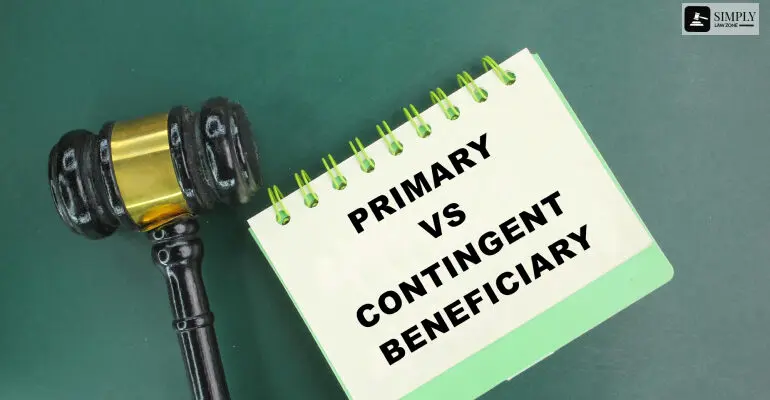
In the intricate web of estate planning, the terms “primary” and “contingent” beneficiaries often weave a complex tapestry. As we step into 2024, let’s unravel the threads and explore the key differences between primary vs. contingent beneficiary in ensuring the smooth transfer of assets.
Primary Vs. Contingent Beneficiary: Definition
A primary beneficiary is an individual or entity designated to receive the proceeds of a life insurance policy, retirement account, or other financial assets upon the death of the account or policyholder. Moreover, The primary beneficiary is the first in line to receive the benefits or assets, and they take precedence over any contingent or secondary beneficiaries.
Here are the key characteristics of a primary beneficiary:
Designation
The policyholder or account owner explicitly names the primary beneficiary when establishing the policy or account. Moreover, This designation is a crucial part of the estate planning process.
Distribution Priority
In the event of the policyholder’s death, the primary beneficiary is the first party entitled to receive the benefits or assets. Moreover, The distribution process begins with the primary beneficiary.
Claiming Benefits
The primary beneficiary is required to file a claim to receive the benefits. Moreover, this involves submitting necessary documentation to the insurance company or financial institution, such as a death certificate.
Can Be Individuals or Entities
A primary beneficiary can be an individual, such as a spouse, child, or friend, or it can be an entity like a trust or charity. Moreover, The policyholder has the flexibility to choose who will be the primary beneficiary.
May Specify Percentages
In cases where there are multiple primary beneficiaries, the policyholder may specify the percentage of the benefits that each beneficiary is entitled to receive. Moreover, This allows for a more customized distribution of assets.
Revocable Designation
In many cases, the policyholder retains the right to change the primary beneficiary designation during their lifetime. Moreover, This flexibility enables individuals to adapt their estate plans to changing circumstances.
It’s important for individuals to regularly review and update their beneficiary designations to ensure that they align with their current wishes and circumstances. Moreover, Failure to designate a primary beneficiary or keeping beneficiary designations outdated may lead to complications in the distribution of assets after the policyholder’s death.
A contingent beneficiary is an individual or entity named in a life insurance policy, retirement account, or other financial asset to receive the proceeds or benefits if the primary beneficiary is unable or unwilling to do so. The contingent beneficiary comes into play if certain conditions specified in the policy or account are met, typically the death of the primary beneficiary.
Here are the key features of a contingent beneficiary:
Secondary Recipient
The contingent beneficiary is a backup or secondary recipient designated to receive the benefits in case the primary beneficiary is no longer eligible to claim them. Common reasons for the primary beneficiary being unable to receive the benefits include death, refusal, or incapacity.
Triggering Event
The contingent beneficiary receives the benefits upon the occurrence of a triggering event, most commonly the death of the primary beneficiary. Once this event occurs, the contingent beneficiary steps into the position originally designated for the primary beneficiary.
Designation by the Policyholder
Similar to the primary beneficiary, the policyholder or account owner designates the contingent beneficiary when establishing the policy or account. This designation is typically included in the beneficiary section of the relevant documentation.
Succession of Beneficiaries
The contingent beneficiary provides a succession plan for the distribution of benefits. If the primary beneficiary is not able to claim the benefits, the contingent beneficiary assumes the role of the primary recipient.
Flexibility in Designation
The policyholder has the flexibility to name one or more contingent beneficiaries and can specify the percentage of benefits each contingent beneficiary is entitled to receive. This allows for a tailored distribution plan.
Regular Review
It’s advisable for individuals to regularly review and update their contingent beneficiary designations to ensure they align with their current intentions. Life events such as marriages, divorces, or changes in family dynamics may necessitate updates.
Preventing Lapses
Having a contingent beneficiary helps prevent the lapse of benefits in case the primary beneficiary is unable to claim them. This ensures a smoother and more efficient transfer of assets according to the policyholder’s wishes.
Contingent beneficiaries play a crucial role in estate planning, providing an additional layer of security and clarity in the distribution of assets. As with primary beneficiaries, individuals should be mindful of keeping contingent beneficiary designations up to date to reflect changes in personal circumstances or preferences.
Primary Vs. Contingent Beneficiary: Differences
In the theater of financial planning, the roles of primary and contingent beneficiaries take center stage, each playing a distinct part in the grand performance of asset distribution. Let’s unravel the captivating differences that set these characters apart in this captivating saga.
1. Primary Beneficiary
We have the primary beneficiary—the star of the financial drama. They take precedence in the beneficiary hierarchy, being the initial and primary recipient of the benefits.
Ready to claim the benefits directly? The primary beneficiary is the immediate heir or entity chosen by the account owner to receive the assets upon a triggering event, such as the account holder’s passing.
As the curtains rise, the primary beneficiary kicks off the distribution proceedings. They are the first in line, with all benefits flowing through their hands to begin the financial distribution.
The designation of a primary beneficiary is a carefully choreographed decision made by the account owner. It’s a customizable move, allowing flexibility in tailoring the financial performance to individual preferences.
2. Contingent Beneficiary
As the primary beneficiary takes charge, the contingent beneficiary waits, ready for action. They are the supporting act, assuming a crucial role if the primary beneficiary is unable or unwilling to claim the benefits.
The contingent beneficiary’s moment arrives when triggered by specific events, often the passing of the primary beneficiary. They are the secondary recipients, stepping forward to claim the benefits as per the designated succession plan.
While not the headliners, contingent beneficiaries are integral to the symphony of asset distribution. They ensure a seamless transition, preventing lapses in benefit claims and keeping the financial performance on track.
Having a contingent beneficiary is like a well-crafted plot twist—it prevents unexpected turns. If unforeseen circumstances prevent the primary beneficiary from claiming the benefits, the contingent beneficiary ensures the story continues without a hitch.
Final Words
As we navigate the intricate world of beneficiaries in 2024, the roles of primary and contingent beneficiaries have become more nuanced. Picture it as crafting a symphony where each beneficiary plays a unique note, contributing to the harmonious transfer of assets. By staying informed, adapting to changes, and fostering open communication, you can orchestrate a masterpiece in your estate planning journey. Here’s to clarity, flexibility, and a well-tuned beneficiary ensemble in the years to come!
Read Also:


